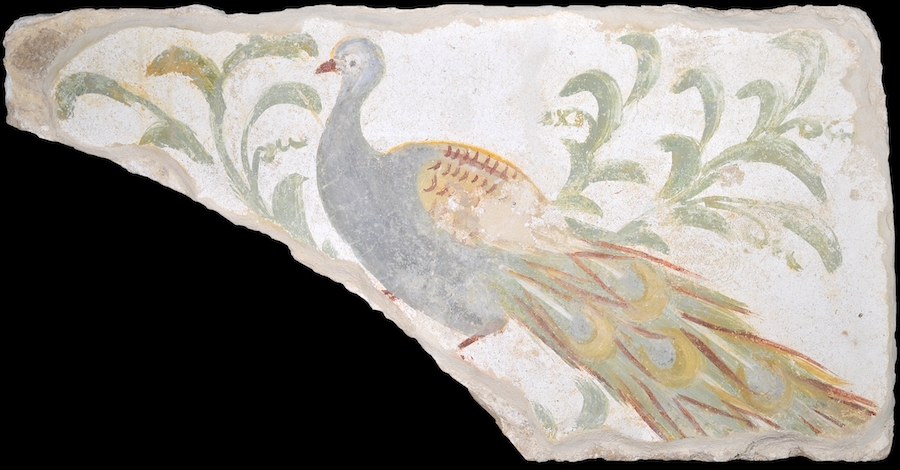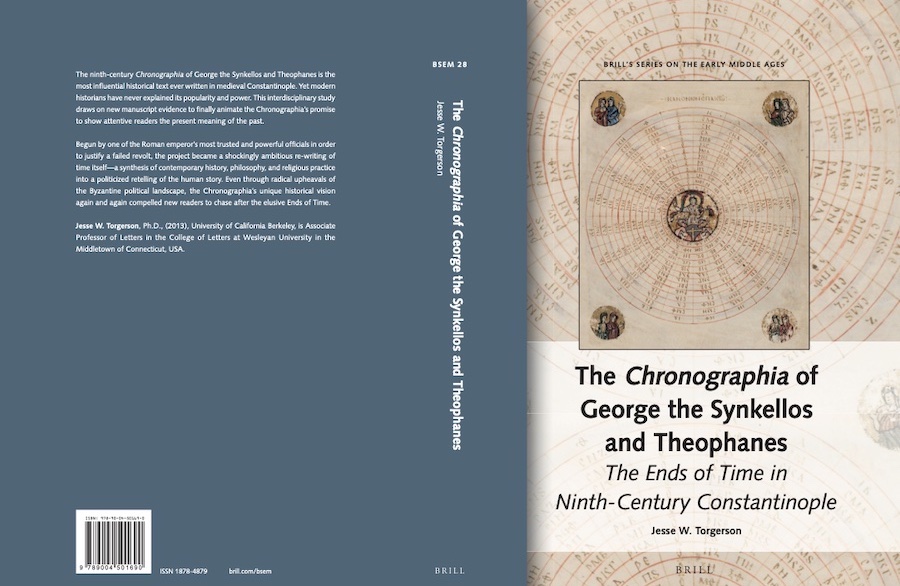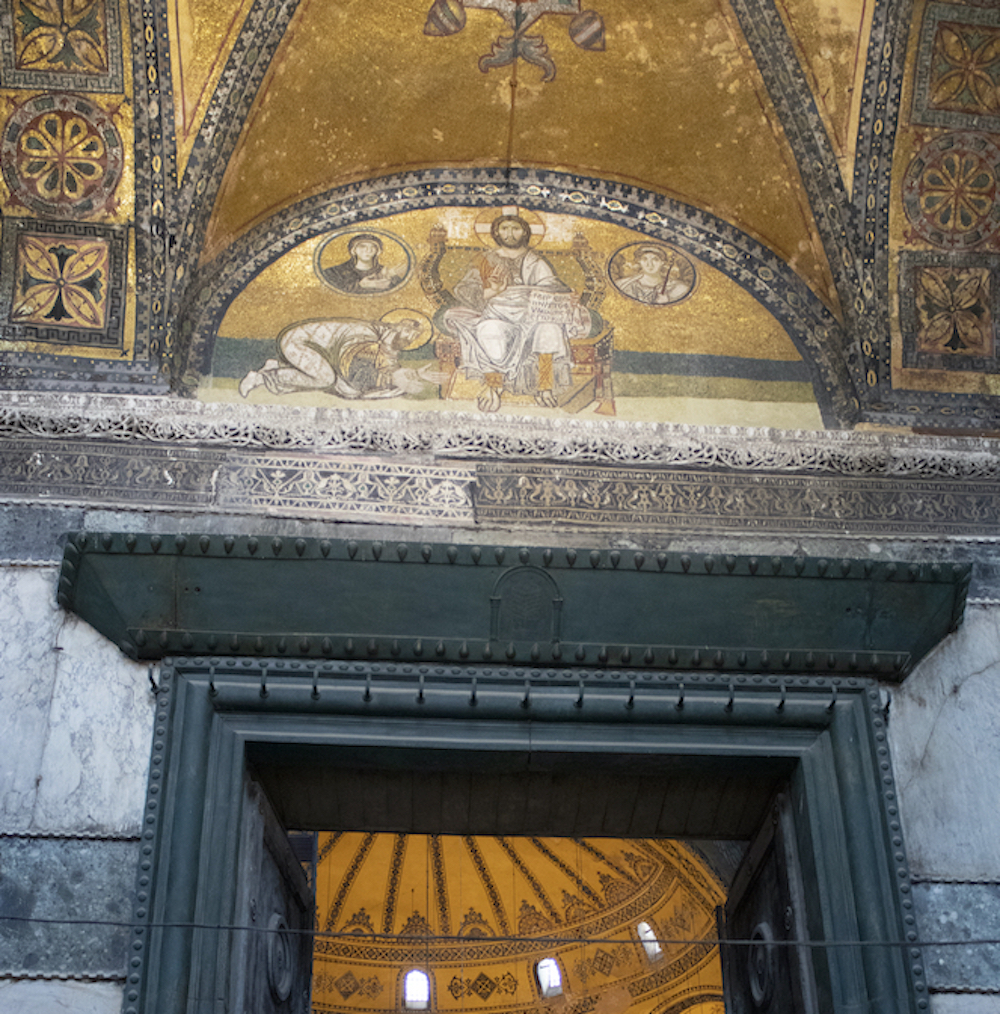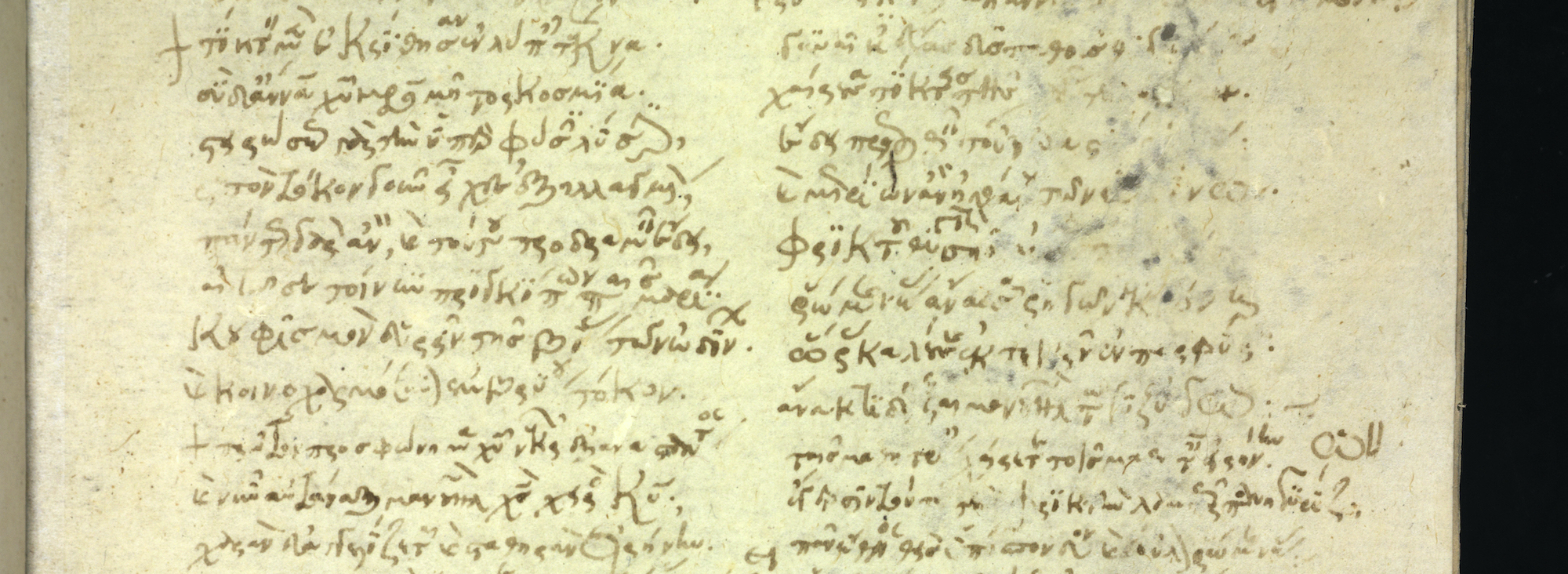Past Recipients
2023–2024
Maria Alessia Rossi, Index of Medieval Art, Princeton University
Visualizing Christ’s Miracles in Late Byzantium: Art, Theology, and Court Culture
Agnieszka E. Szymanska, University of Richmond
Sacred Spectating in Late Antique Egypt: Monastic Painting as Spiritual Experience
2022–2023
Hugh Jeffery, Independent researcher
Middle Byzantine Aphrodisias: The Episcopal Village AD 700-1250

Aphrodisias is one of the best-known archaeological sites in modern Turkey. The Aphrodisias Excavations Project has been ongoing since 1961, and in 2017 the site was inscribed on the UNESCO World Heritage List. The settlement flourished as a monumental city from the first through the sixth centuries AD, and is most famous for the quantity and quality of its marble sculpture. Nevertheless, the settlement continued to be occupied through to the twentieth century and recent excavations have done much to illuminate its medieval and Ottoman life.
Middle Byzantine Aphrodisias appears as the twelfth volume in the series of Aphrodisias monographs, published previously by von Zabern and now by Reichert. It addresses the archaeology of the settlement from the eighth through thirteenth centuries, as medieval dwellings, fields and cemeteries developed in and around the ruins of the ancient city. The volume collates and integrates material already published and presents important new bodies of archaeological evidence. It reconstructs the fabric of the medieval settlement so far as is possible, considering both domestic contexts and medieval interventions in ecclesiastical architecture. It seeks also to investigate the occupation history of the settlement, to explore the social relations between its inhabitants, and to frame the site as a field of action integral to a broader region and political structure. The volume is intended as an exercise in settlement archaeology as social history and as a contribution to the study of the Middle Byzantine Maeander Valley.
Interpretive discussion is organised into five chapters. The second chapter presents a topographic gazetteer of Middle Byzantine activity at Aphrodisias, considering the likely extent of medieval occupation and the nature of domestic and ecclesiastical architecture. The third chapter addresses the monetary economy of the Morsynos Valley, offering an interpretation of a catalogue of 712 coins from Aphrodisias and surrounding modern villages. The subsequent chapter analyses a corpus of over two hundred items of liturgical and architectural sculpture, reconstructing medieval interventions within the settlement’s churches. The fifth chapter addresses the funerary archaeology of the settlement, documenting the major cemeteries and interpreting their development. The sixth and final chapter considers how Byzantine Aphrodisias fits within the typology of contemporary settlements within the wider region. The settlement is compared with those at Amorion, Miletos, Ephesos and Hierapolis.
Monographs in the Aphrodisias series are carefully produced hardback volumes, with high quality illustrations and extensive use of monochrome photographs. The production of such volumes would not be possible without the financial support of institutions such as the Mary Jaharis Centre. The subvention, together with a further grant from the Oxford Centre for Byzantine Research, made a significant contribution to the cost of publication.
2021–2022
Julia Burdajewicz, Academy of Fine Arts in Warsaw and University of Warsaw
Porphyreon in the Sidonian Hinterland: Late Antique Wall Paintings from the Basilica and Residential District

On a spring day in 1975, a bulldozer excavating sand on the beach near the village of Jiyeh (southern Lebanon) pulled out of the dunes dressed stones with remains of wall paintings. This accidental discovery prompted full-scale excavations, which led to the discovery of a Late Antique settlement, identified later with ancient Porphyreon. Exploration of the residential district and a large early Christian basilica brought to light close to 300 fragments of wall paintings representing jeweled crosses, human figures, animals, plants, geometric motifs, and painted Greek inscriptions. The importance of the discovery was immediately clear: the abundance of the paintings and the iconographic repertoire they represent remain unmatched by the finds from any other Late Antique archaeological site in the Eastern Mediterranean. However, due to the turbulent events of modern Lebanese history, the paintings remained undocumented, unstudied, unpublished, and virtually forgotten in a dusty storage room of a local museum until 2014, when comprehensive research was finally possible. The book presents the results of this research.
The volume begins with an overview of surviving examples of Late Antique wall paintings in the Levant and historical sources that mention such decorations, making a case for the uniqueness and importance of the fragments from Porphyreon, an importance not immediately apparent in view of their fragmentary state. The second chapter presents a chronology of the basilica and the houses, as well as a description of the architecture and of the construction techniques employed. The story of the explorations told in that chapter facilitates an understanding of how the circumstances of discovery affected current study possibilities and why many questions regarding the paintings will likely never be answered.
The next section of the volume deals with the materiality of the paintings: the findings of the archaeometric study, which comprised an examination of mineral substrates and paint layers, shed light on the manner of execution of the paintings and the materials employed. A chapter on a conservation project, which accompanied the research on the paintings, gives readers an all-rounded perspective of the current condition of these finds: their initial state of preservation, the different deterioration processes, and the conducted conservation treatments.
In the second half of the book, the wall paintings from Porphyreon are placed within a broader context: architectural, iconographic, semantic, stylistic, and chronological. The overall iconographic programs deployed in the basilica and in the houses are discussed, explaining the meanings of particular paintings and suggesting possible compositional schemes. Special attention is paid to the role of painted inscriptions in ecclesiastical and domestic spaces. A close stylistic study of the wall paintings reveals the presence of several different painting styles, the “hands” of the artists, and their varying levels of proficiency. Finally, an analysis of the body of evidence – archaeological data, style and iconography, and technical observations – leads to a proposed dating of the paintings. All the fragments are presented in the form of an illustrated catalog.
High-quality illustrations are essential in any publication on visual arts, but for the wall paintings from Porphyreon, locked in a museum storage room and thus, inaccessible to the broader public and scholars, they seemed especially important. The number of illustrations accompanying the text and the catalog of paintings generated substantial costs related to image editing and formatting. The generous Mary Jaharis Centre Publication Grant covered these costs, ensuring the highest standards of digital and print images. In addition, the remuneration of a proofreader and copy-editor was partly covered by the grant.
The book will be published by Peeters Publishers in the Polish Publications in Mediterranean Archaeology series in winter 2022/2023.
Depiction of a peacock from the early Christian basilica at Porphyreon, 5/6th c., 41 x 75 cm. Photo: J. Burdajewicz
Jesse W. Torgerson, Wesleyan University
The Chronographia of George the Synkellos and Theophanes: The Ends of Time in Ninth-Century Constantinople

In its era, the Chronographia project of George the synkellos and Theophanes was a masterwork which redefined the genre of Greek historical literature. The jointly-authored chronography was written in Constantinople between ca. 808–815 as an account of the entire human history of the world, from the first moment of creation to the beginning of the reign of Leo V (r. 813–820). The work quickly came to stand above all other contemporary Byzantine historical texts: two-and-a-half centuries of subsequent medieval Greek historians and chronographers framed their narratives of the Roman Empire as either direct continuations or imitations of the Chronographia. Modern historians also acknowledge it as “the greatest achievement of Byzantine historical scholarship” and as an “undertaking on a scale and of a precision never attempted in the history of Byzantine scholarship.” Nevertheless, there has been a catch in the work’s modern reception. Scholars have also been deeply critical, judging the Chronographia to be a compilation without narrative unity, a mere dossier.
Based directly on a new approach to the surviving ninth-century manuscripts of the Chronographia, this book locates the apparent contradiction between those assessments in the different forms in which, and the different ends for which, medievals and moderns read the Chronographia. Whereas previous studies have primarily used the Chronographia as a source on the historical events it describes or on the older texts which it transmits in excerpts, this new study reprioritizes the medieval Byzantine ends of the project in order to ask new historical questions of the era which produced and then re- edited it. In doing so the project not only offers new avenues of research for Byzantinists studying ninth century political and historical discourses, but it proposes a new approach to studying early medieval chronography in general by tracking the ends or purposes for which such texts communicated meaning about the past within their own present.
The Mary Jaharis Center publication grant made it possible for The Chronographia of George the Synkellos and Theophanes to be published as a an open-access digital book, both a downloadable PDF and as an html-encoded text that can be read entirely online.
2020–2021
Roland Betancourt, UC Irvine
The Byzantine Gospel Lectionary: Text, Image, and Sound in the Divine Liturgy

Tracing the Gospel text from script to illustration to recitation, Performing the Gospels in Byzantium: Sight, Sound, and Space in the Divine Liturgy (Cambridge University Press, 2021) looks at how illuminated manuscripts operated within ritual and architecture. Focusing on a group of richly illuminated lectionaries from the late eleventh century, the book articulates how the process of textual recitation produced marginalia and miniatures that reflected and subverted the manner in which the Gospel was read and simultaneously imagined by readers and listeners alike. This unique approach to manuscript illumination points to images that slowly unfolded in the mind of its listeners as they imagined the text being recited, as meaning carefully changed and built as the text proceeded. By examining this process within specific acoustic architectural spaces and the sonic conditions of medieval chant, the volume brings together the concerns of sound studies, liturgical studies, and art history to demonstrate how images, texts, and recitations played with the environment of the Middle Byzantine church.
The book is divided into two sections: the first half focuses on the lectionary’s design from text to illustration, which scrutinizes how artists understood the text and its recitation during the liturgy to produce images that heightened awareness of the readings, challenged readers, and played with the various aural understandings of the text. The second half of the book then turns to the Divine Liturgy itself to flesh out the context in which the Gospel readings were done, explain how medieval readers understood the process of recitation, and how chant and architecture worked together to create a unique soundscape during the liturgy. This book challenges one-to-one readings of iconography in order to appreciate how works of art and architecture shift in meaning depending on the rituals and readings performed in and around them.
The Mary Jaharis Center Publication Grant has offset the impressive costs of this extremely well illustrated volume. In addition to the standard image rights from various libraries, museums, and other repositories, this book also required a host of new and unique images of familiar spaces, such as Hagia Sophia, as well as the digitization of slides of highly inaccessible manuscripts from previous photographic campaigns. Thanks to this grant, the book offers readers the best published photographs (in full color) of many important works of Byzantine manuscript illumination that to date have only been accessible in black-and-white or in poor color reproductions that are now over fifty years old. Not only has the grant allowed me to cover some of these costs, but also to offset the expense of a significant publication subvention that allowed for the book to be published in full-color lithography, ensuring the best possible reproduction of these rare images.
Imperial Doorway, as seen from the Narthex, Hagia Sophia, Istanbul. Photo: Roland Betancourt
Fotini Kondyli, University of Virginia
Rural Communities in Late Byzantium: Resilience and Vulnerability in the Northern Aegean
This book examines Late Byzantine rural communities’ ability to adjust and survive in the face of economic, political, and demographic crises. I bring together new archaeological evidence and archival material pertaining to the islands of Lemnos and Thasos in the Northern Aegean to reconstruct the living conditions of these communities, explore their socioeconomic strategies against crisis, and examine their overall role in the political and economic realities of their time. In doing so I employ a framework of social resilience and islandness in support of new perspectives on Byzantine society and identity as well as new insights pertaining to the Late Byzantine period. By arguing for resilient rather than passive and static island rural communities, I seek to reinstate ordinary people in the historical narrative and reintroduce them as active participants in the Late Byzantine period, pointing to their ability not only to react to change but also initiate it. A social resilience framework also puts social ties, collaborations, and community building on an equal footing with the study of institutions, economy, and power relations, thus contributing to a more holistic and diachronic perspective on successful crisis management.
The stories and experiences of these rural communities also provide a very distinct island perspective to the Late Byzantine period. Considering that most of what we know about this period comes from mainland examples (Constantinople, Macedonia, Asia Minor and the Peloponnese), a focus on island communities offers a new perspective on studying Byzantine society in a period of crisis. While islands are easily imagined as isolated and extremely vulnerable to political, environmental, and economic changes, they can also be incredibly resilient by capitalizing on their island geography and the various degrees of connectivity it allows. Finally, the idea of resilient communities also becomes a vehicle for rethinking the nature of the Late Byzantine period and questions the way in which we discuss notions of decline and collapse and divide historical periods in good and bad ones.
The book is being published by Cambridge University Press and will appear by early 2022. Its publication has been generously supported by a Mary Jaharis Centre Publication Grant to fully cover the book’s subvention.
Late Byzantine tower at the Acropolis of Limenas, Thasos. Photo: Fotini Kondyli
2019–2020
Foteini Spingou, University of Edinburgh
Poetry for the Komnenoi: The Anthology Marciana: Syllogae A, B and C

Hard work and scholarly curiosity have allowed us, the moderns, to learn much about the cultural, intellectual and political life of the twelfth-century South East Mediterranean, but much more remains to be discovered about its politics, culture, and customs. Manuscript Graecus 524 (318) of the Biblioteca Marciana in Venice is a half-published collection of rhetorical and scientific works that demonstrates the necessity of bringing to light and make accessible new texts to a wide audience.
The vast poetic anthology in manuscript Marcianus Gr. 524 has been known to scholars for over a century now, but it was never sufficiently studied or published. My book, Poetry for the Komnenoi, includes a new codicological and palaeographical analysis of the manuscript proving that the Anthologia Marciana (= AM) was compiled around the year 1200 and subsequently modified around 1280/90 by scribes active in Constantinople. The re-arrangement of the manuscript’s pages shows that the AM is structured in ten books comprising long poems, single author poetic collections, and three micro-anthologies of poetry; overall, these texts equal to around the 1/3 of the surviving twelfth-century poetry. While the long poems and single-author collections have been systematically studied*, the three micro-anthologies or Syllogae A, B and C, as I name them, remain poorly known**. The first critical edition, translation and a full commentary for the 190 poems (or 3,298 verses) from the Syllogae are the focus of my book.
These texts are about otherwise unknown objects, customs, and individuals. They were written in Constantinople by professional poets mainly between 1130s and 1170s on behalf of commissioners settled in the Byzantine Capital and other cities along the Via Egnatia, as well as Kiev and, perhaps, even Sicily. The poems in the three Syllogae are epitaphs, dedicatory epigrams on works of art, book epigrams, ethopoiiae, and laudatory poems for the emperor and his family that uniquely attest forms of pictorial compositions and objects, contemporary intellectual, political and pilgrimage networks, as well as ritual practices for commemorating the dead and praying for the fulfilment of hopes and dreams of the living.
The publication of a book that invites us all to discover a new source for the Byzantine Culture would have never been possible without a Mary Jaharis Centre Publication Grant. The Publication Grant allowed me to hire a professional copy-editor to curate the pre-submission text of the book manuscript. Most importantly, the Centre’s support gave me inspiration and encouragement to continue and bring to a conclusion this grant project. I will always remain grateful for this opportunity.
The book will be published in the Series Oxford Studies in Byzantium.
* Giulia Maria Paoletti is currently preparing an edition of the so-far unpublished Poem on the Tooth-Ache.
** Spyridon Lambros transcribed (but did not edit) selected poems from the AM that according to him could contribute to the study of the region’s political history (see, Neos Hellenomnemon 8 [1910]: 3–59, 123–92). Konstantin Horna had already prepared a complete edition of all the poems in the anthology. As he states in a letter to Lambros, his edition remained unpublished because he could not identify the authors of the poems. Their letter exchange will be included in the appendix of the book.
Venice, Biblioteca Nazionale Marciana, manuscript Graecus Z 524 (=318), 13th c., f. 39r (Detail). ©BNM
2017–2018
Elissavet Tzavella, Open University of Cyprus
Byzantine Attica: Urban and Rural Landscape in the Early and Middle Byzantine Periods (4th–12th century)
This book is a synthesis of archaeological and historical investigation in the region of Attica from Late Antiquity to the end of the Middle Byzantine period. While the town of Athens has been explored by specialized scholars, the evolution of the Attic countryside remains neglected. The territory surrounding modern Athens, however, has been investigated intensively through excavation during the last four decades, due to intensive building development in and around the modern capital city of Greece. Results of these excavations datable to the Byzantine period were collected and provided the backbone of the present study, combined with excavation results from systematic excavations, literary sources, epigraphy, sigillography, numismatics, and accounts of early travellers.
The book starts by presenting the geography and natural environment of Attica as factors which dictate many aspects of the human-made environment in the long durée. Subsequently, the road and maritime networks of Byzantine Attica, based on up-to-date archaeological research, are presented. The main body of evidence regarding settlement, economic activity, defence and religious institutions is presented in the next three chapters, ordered chronologically: Late Antiquity (4th to mid-7th century), the “Transitional” period (mid 7th to 9th century), and the Middle Byzantine period (10th to 12th century). Discussion and concluding remarks are presented in the next chapter. The final chapter consists of a gazetteer of Byzantine sites in Attica, in which all relevant evidence is organized geographically.
The book is planned to appear in the Medieval and Post-Medieval Mediterranean Archaeology Series of Brepols Publishers in 2019, size 178 x 254 mm, ca. 400 pages. The publication will include 191 black-and-white images, 5 colour images, and 11 colour maps.
Thanks to the Mary Jaharis Publication Grant 2017-2018, many aspects of the monograph under publication were improved greatly in comparison with the previous status of the study as a PhD. The final text was revised thoroughly by a professional language editor and native speaker of the English language. A total of sixteen colour images were included in the final publication. The maps of the geographic entities of Attica, which had been designed in Adobe Photoshop CS2.1 for the submission of the PhD by the author, were now improved in Adobe Photoshop CS5.1 by a professional graphic designer. Copies of one colour image of the Peutinger Table, as well as a black-and-white photograph of an Attic monument, were purchased from the institutions which are responsible for the print rights of these images respectively. Finally, numerous general aspects of the organization of the text and the other materials were improved by a professional editor.